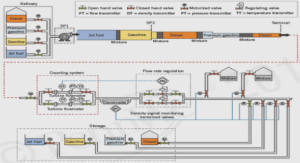IMPACT D’UNE REDUCTION DE SEL ET DE NITRITE SUR LE COMPORTEMENT D’UN ECOSYSTEME DE JAMBON SIMPLIFIE
CONSTITUTION D’UNE BANQUE DE SOUCHES ISOLEES DE JAMBONS
Dans l’optique de constituer une communauté synthétique, nous avons réalisé une banque de souches bactériennes isolées de jambons de l’usine de production étudiée (issus des différentes campagnes d’échantillonnage, produits sur différentes lignes de tranchage et avec des emballages ayant différentes perméabilités à l’O2). Des isolats ont été collectés sur différents milieux de culture (MRS, BHI, Columbia agar avec 5 % de sang de mouton) contenant du bleu de Bromocrésol, afin de colorer différentiellement les colonies et d’aider à l’identification visuelle des différents morphotypes. Différentes conditions de croissance (aérobie/anaérobie) ont également été testées pour maximiser le spectre d’espèces et de souches isolées. Après 72 h d’incubation des souches pures à 20 °C dans leurs milieux de culture liquide respectifs, les bactéries ont été collectées pour extraction d’ADN. Une première série d’identifications par PCR quantitative a ensuite été réalisée à l’aide d’amorces spécifiques des espèces identifiées dans le chapitre 2 comme les plus fréquentes sur ces jambons. La séquence de ces amorces est renseignée dans la section Materials and Methods du chapitre 3. Cette première analyse a permis l’identification de 50 % des isolats. Les isolats restants ont été identifiés par séquençage du gène SSU rRNA complet (1,5 kb) et assignation taxonomique par alignement sur les bases de données de références. Tous les isolats ont pu être identifiés à l’échelle de l’espèce par alignement sur les génomes disponibles, à l’exception de deux souches de Carnobacterium et d’Enterococcus, alignées uniquement à l’échelle du genre, et constituant potentiellement de nouvelles espèces. Il peut être noté que le grand nombre de souches récoltées a permis d’isoler les deux sous-espèces de L. gelidum (subsp. gelidum et gasicomitatum) ainsi que des espèces identifiées comme sous-dominantes dans les jambons de cette usine (par exemple : M. psychrotolerans ou P. fluorescens). En somme, 157 isolats correspondant à 19 espèces différentes ont été identifiés ( voir Figure 24).
Impact d’une réduction de sel et de nitrite sur le comportement d’un écosystème de jambon simplifié
Figure 24 : Bilan de l’identification des isolats étudiés Pour les espèces les plus abondantes dans les échantillons de jambons, une même espèce était parfois représentée par plusieurs isolats, correspondant potentiellement à différentes souches. La Table 8 établit la traçabilité de ces isolats en fonction des conditions de production
Identification of the bacterial isolates by quantitative PCR
For each isolate, a set of primers targeting nine different species (corresponding to the core species on ham) was tested for species level identification. The sequence of the primers are available in Table S1. Each analysis was performed in duplicate and included a positive control (strain of the targeted species) and a negative control (sterile water). DNA was diluted 10 times to avoid inhibitors effect. PCR mix was composed of 0.4 µL of reverse primer at 10 µM, 0.4 µL of forward primer at 10 µM, 10 μl of SYBR MESA GREEN master mix reagent kit (Eurogentec, Liège, Belgium), 4.2 µL of sterile water and 5 µL of diluted DNA. Quantitative PCR was performed with Realplex thermal cycler (Eppendorf, Hamburg, Germany), using the following program: Taq polymerase activation at 95°C for 2 min, 40 cycles of denaturation at 95°C for 15 s and annealing at 60°C for 1 min. It ended with melting-curve checking at 95°C for 15 s, 1 min at 60°C, and 20 min ramp from 60°C to 95°C. A mean threshold cycle (Ct) per sample was calculated out of Ct from the duplicates. Among amplifications with all couples of primers, each strain was identified to the species for which primers allowed the best amplification (meaning with the lowest Ct).
Impact d’une réduction de sel et de nitrite sur le comportement d’un écosystème de jambon simplifié
Synthetic bacterial consortium preparation and inoculation on simplified ham The nine species’ isolates chosen for the synthetic community were available in glycerol stock. They were plated on growth agar medium in order to check the presence of eventual contaminations. For each isolate, one colony was picked and grown in liquid broth corresponding to the medium used for initial isolation (MRS of BHI). After incubation overnight at 20°C in FRIOCELL 55 refrigerated incubator, bacterial cell concentration was estimated by optical density (OD) measurement at 600 nm with Visible Light Advanced Spectrophotometer 230 VAC Secomam Prim (Aqualabo, Champigny, France). Knowing the average bacterial cell concentration in each strain broth, a solution of water containing the nine isolates was prepared just before inoculation, with a concentration of 105 cfu/mL of each strain. Solid “ham-like” agar disks at various salt and nitrite concentrations were inoculated on the two sides using a sterile spray filled with the solution containing the nine strains. Volume of spray was adjusted in order to inoculate agar at a total bacterial concentration of 104 cfu/g. For each salt and nitrite concentrations corresponding to solutions S1 to S8, biological triplicates, corresponding to three inoculated agar, were performed. For the sample corresponding to solution S9, at the center of the experimental design, three additional biological replicates were performed. Inoculated agar were packed under Modified Atmosphere Packaging (50% N2 / 50% CO2) with SEINE machine (Milord, Verberie, France) and were stored at 8°C in FRIOCELL 55 refrigerated incubator for 4 days (S9), 6 days (S2, S4, S6, S8), 10 days (S1, S3, S5, S7, S9), 14 days (S2, S4, S6, S8) or 16 days (S9).



